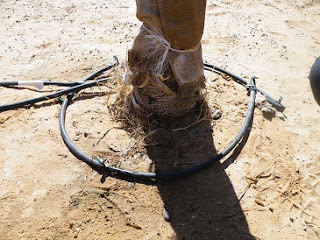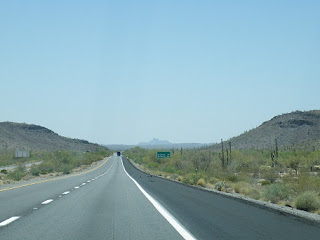Historically dates have been grown on the valley floor with little altitude above the height of the Colorado River, and indeed sea level. In some date gardens the water table is as close as one metre down. These areas are loamy clay and flood irrigated. In recent decades date production has expanded onto the mesa which is higher ground surrounding the valley, where land is more available and initially cheaper to purchase.

This morning Dave Mansheim, President of the Bard Valley Medjool Date Growers Association took us to the plantation he manages on the mesa. These dates grow on sandier soils which are free draining and typically irrigated via a drip system. We were interested in seeing how this plantation was established where Dave has levelled land and planted date palms on terraces which have superb views over the valley floor. This concept of landscape terracing lends very nicely to real estate opportunities which may arise should urbanization continue.
Dave's management method for dealing with the large volume of date palm prunings was also of great interest - disposing of fronds on-site, leaving in alternate rows. Later a flail shredder passes over the fronds chopping into pieces. This residue sits ontop of the ground as mulch eventually breaking down.
 Dave Mansheim with Dave & Anita
Dave Mansheim with Dave & Anita

We met with Steve and Ron who also showed us their date gardens and had an opportunity to look at offshoot removal and methods used. Of particular interest was the sledgehammer chisel attached to a bobcat (skidsteer), used instead of the traditional handheld chisel and hammer. This method ensures workmen can work all day on removal instead of being worn out from swinging a sledgehammer - and we may well adopt for our own offshoot removal.

Went to Ron's place and looked at various tools and machinery used in date production including construction of cages for high picking, flail shredder (this photo), hydraulic frond pruners, pollen blowers, an assortment of bunch bags and old and new fruit trays.
(This photo: Ron & Dave inspecting the flail shredder)

We spent time with Glen V who swung by and showed us the original 6 Medjool which came to Yuma in approx 1944. A source of inspiration for us - as we see today, there are thousands of acres of Medjool palms descended from these original 6 which were the nucleous of the now very large Medjool industry in Bard/Yuma. It gives us hope that the date palms we have introduced to Australia may someday result in the growth of a commercial industry such as we see here in the USA.
(This photo: Glen with Jonte & Dave)


Had a look at plantations Glen is involved in which included mature fruiting palms down to recently established plantations.We looked at freshly planted offshoots and the technique Glen uses to establish new gardens.

Saw teams of workers completing fruit thinning. We also looked at some Barhee date palms to see their fruit set. Glen was kind enough to show us a tree shaking machine he uses to shake ripened dates from bunches with minimum manual picking; a pollen extracting machine and blowers used to pollinate date palms at flowering. Dinner at Burgers & Beer with members and their wives from the Date Growers Association.
 Today we moved from Yuma, Arizona to the Coachella Valley in California. (This photo: date retail shop, Bard Valley).
Today we moved from Yuma, Arizona to the Coachella Valley in California. (This photo: date retail shop, Bard Valley). We drove through some fascinating country including the Imperial Dunes - rolling white sand dunes - where some of the Star Wars movies were filmed. In the distance we could see the fence of the Mexican border.
We drove through some fascinating country including the Imperial Dunes - rolling white sand dunes - where some of the Star Wars movies were filmed. In the distance we could see the fence of the Mexican border. Date production in the Coachella Valley differs from the Yuma area. In Coachella the major date variety grown is the Algerian variety Deglet Noor which makes up approx 70% of all plantings. This variety also differs in appearance to the Medjool. Other varieties grown include Halawi, Thoory, Zahidi, Khadrawy, Honey, Black Sphinx and Tarbazal. In total there are approx 8000 acres of dates grown in this area.
Date production in the Coachella Valley differs from the Yuma area. In Coachella the major date variety grown is the Algerian variety Deglet Noor which makes up approx 70% of all plantings. This variety also differs in appearance to the Medjool. Other varieties grown include Halawi, Thoory, Zahidi, Khadrawy, Honey, Black Sphinx and Tarbazal. In total there are approx 8000 acres of dates grown in this area. Glenn took us to the USDA date collection at Thermal and introduced us to Vince. It was a very special experience seeing this collection as we have collected a lot of information over the years and read a lot on the work of the USDA.
Glenn took us to the USDA date collection at Thermal and introduced us to Vince. It was a very special experience seeing this collection as we have collected a lot of information over the years and read a lot on the work of the USDA. We actually got to see palms which the likes of Nixon and Carpenter had bred and we discussed results on the various varieties.
We actually got to see palms which the likes of Nixon and Carpenter had bred and we discussed results on the various varieties.
 Tasted an enormous amount of different varieties that we hadn't tried before and looked at some of the equipment used for pruning and offshoot removal.
Tasted an enormous amount of different varieties that we hadn't tried before and looked at some of the equipment used for pruning and offshoot removal.




































....jpg)




